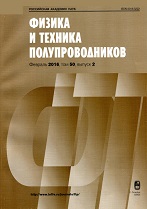|
This article is cited in 3 scientific papers (total in 3 papers)
Semiconductor structures, low-dimensional systems, quantum phenomena
On the thermal activation of conductivity electrons in a $p$-type HgTe/CdHgTe double quantum well with HgTe layers of critical width
S. M. Podgornykhab, M. V. Yakuninab, S. S. Krishtopenkoc, M. R. Popova, N. N. Mikhailovd, S. A. Dvoretskiid
a Institute of Metal Physics, Ural Division of the Russian Academy of Sciences, Ekaterinburg
b Ural Federal University named after the First President of Russia B. N. Yeltsin, Ekaterinburg
c Institute for Physics of Microstructures, Russian Academy of Sciences, Nizhnii Novgorod
d Rzhanov Institute of Semiconductor Physics, Siberian Branch of Russian Academy of Sciences, Novosibirsk
Abstract:
The temperature dependences of the Hall coefficient and magnetoresistivity of a $p$-type HgTe/CdHgTe double quantum well with HgTe layers of critical thickness in the temperature range $T$ = 35–300 K under magnetic fields up to 9 T are investigated. The position of the earlier observed reentrant quantum Hall transition from plateau $i$ = 1 to plateau $i$ = 2 is found to be close to the transition field from light to heavy holes with an increase in the magnetic field in the classical Hall effect. It is found that thermally activated light electrons contribute to the Hall effect along with light and heavy holes at $T\ge$ 35 K. The activation energy of electrons is estimated from the temperature dependence of the electron concentration as 28 meV, which exceeds the calculated value from the lateral maximum of the valence subband to the edge of the lowest conduction subband, probably because of heterostructure asymmetry.
Received: 19.02.2019
Revised: 26.02.2019
Accepted: 26.02.2019
Citation:
S. M. Podgornykh, M. V. Yakunin, S. S. Krishtopenko, M. R. Popov, N. N. Mikhailov, S. A. Dvoretskii, “On the thermal activation of conductivity electrons in a $p$-type HgTe/CdHgTe double quantum well with HgTe layers of critical width”, Fizika i Tekhnika Poluprovodnikov, 53:7 (2019), 935–939; Semiconductors, 53:7 (2019), 919–922
Linking options:
https://www.mathnet.ru/eng/phts5458 https://www.mathnet.ru/eng/phts/v53/i7/p935
|


| Statistics & downloads: |
| Abstract page: | 33 | | Full-text PDF : | 5 |
|



 Contact us:
Contact us: Terms of Use
Terms of Use
 Registration to the website
Registration to the website Logotypes
Logotypes